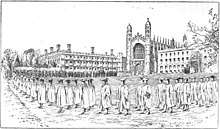Charles Simeon
Charles Simeon (24 September 1759 – 13 November 1836), was an English evangelical clergyman.
Charles Simeon | |
|---|---|
 Portrait of Charles Simeon | |
| Born | 24 September 1759 Reading, Berkshire, England |
| Died | 13 November 1836 (aged 77) |
| Nationality | English |
| Relatives | Sir John Simeon, 1st Baronet (brother) Sir Richard Simeon, 2nd Baronet (nephew) Sir John Simeon, 3rd Baronet (great-nephew) |
Biography
He was born at Reading, Berkshire in 1759 and baptised in the parish church on 24 October of that year.[1][2] He was the fourth and youngest son of Richard Simeon (died 1784) and Elizabeth Hutton.[3] His eldest brother, named Richard after their father, died early. His second brother, John, entered the legal profession, became an MP and received a baronetcy. The third brother, Edward Simeon, was a director of the Bank of England.[1]
Simeon was educated at Eton College and King's College, Cambridge.[2] As an undergraduate at King's from 1779, brought up in the High Church tradition, he read The Whole Duty of Man and then a work by Thomas Wilson on the sacrament, and taking communion at Easter experienced a Christian conversion. In 1782 he became Fellow of King's College, and was ordained deacon, then graduating B.A. in 1783. He began as a minister as deputy to Christopher Atkinson (1754–1795), at St Edward King and Martyr, Cambridge. Atkinson introduced him to John Venn and Simeon then met Henry Venn, confirming evangelical and Calvinist views.[4]
Simeon received the living of Holy Trinity Church, Cambridge, in 1783. The appointment, technically a curacy, followed the death of the Rev. Henry Therond. Simeon's father intervened with James Yorke, the Bishop of Ely, and he was appointed, under the age of 23, as a curate-in-charge for the bishop.[5] He was at first unpopular, and indeed the congregation would have preferred John Hammond (died 1830), who had been curate there, and became lecturer. Services were disrupted, and he was insulted in the streets.[6][7][8] Simeon remained there for the rest of his life, eventually with a crowded church.[4]
Simeon died, unmarried, on 13 November 1836,[4] and was buried on the 19th in King's College Chapel, Cambridge.[9] His memorial by Humphrey Hopper in Holy Trinity Church (Cambridge), was described by architectural critic Nikolaus Pevsner as an "epitaph in Gothic forms."[10][11]
Influence

Simeon gained influence among the undergraduates of the university. He became a leader among evangelical churchmen, and was one of the founders of the Church Missionary Society in 1799. He also helped found the London Society for Promoting Christianity Amongst the Jews (now known as the Church's Ministry Among Jewish People or CMJ) in 1809, and acted as adviser to the British East India Company in the choice of chaplains for India.[6]
According to the historian Thomas Macaulay, Simeon's "authority and influence… extended from Cambridge to the most remote corners of England, … his real sway in the Church was far greater than that of any primate." [12]
Works
In 1792 Simeon read An Essay on the Composition of a Sermon by the French Reformed minister Jean Claude. Simeon found that their principles were identical and used the essay as the basis for his lectures on sermon composition. Claude’s essay also inspired Simeon to make clear his own theological position. He published hundreds of sermons and sermon outlines (called "sermon skeletons"), still in print, that to some were an invitation to clerical plagiarism. His chief work is a commentary on the whole Bible, entitled Horae homileticae (London).
Legacy
Simeon is remembered in the Episcopal Church of the United States with a Lesser Feast and in the Anglican Church of Canada with a Commemoration on 13 November.[13] In the Church of England he is remembered with a Lesser Festival on 13 November. He established what is now the Charles Simeon Trust, for the purpose of acquiring church patronage to perpetuate evangelical clergy in Church of England parishes.[6] It arose from the bequest of John Thornton, who died in 1813, of ten advowsons, left to a trust, of which Simeon was one of the trustees. Simeon expanded the group of livings with money he had inherited.[4] It continues to operate to this day.[14]
Notes
- Simeon 1847, p. 2.
- "Simeon, Charles (SMN779C)". A Cambridge Alumni Database. University of Cambridge.
- Simeon 1847, pp. 1–2.
- Cowie, Leonard W. "Simeon, Charles". Oxford Dictionary of National Biography (online ed.). Oxford University Press. doi:10.1093/ref:odnb/25559. (Subscription or UK public library membership required.)
- Charles Smyth (29 January 2015). Simeon and Church Order. Cambridge University Press. p. 37. ISBN 978-1-107-45882-6.
- Chisholm, Hugh, ed. (1911). . Encyclopædia Britannica. 25 (11th ed.). Cambridge University Press.
- Hugh Evan Hopkins (24 January 2012). Charles Simeon of Cambridge. Wipf and Stock Publishers. pp. 38 and 43. ISBN 978-1-61097-813-2.
- Persons: Hammond, John (1778–1787) in "CCEd, the Clergy of the Church of England database" (Accessed online, 11 March 2017)
- Thomas Henry Case (1899). Memoirs of a King's College Chorister. W.P.Spalding.
- Nikolaus Pevsner. Cambridgeshire. "The Buildings of England." Second Edition (London: Penguin Books, 1970), p.231.
- "Church of the Holy Trinity – 1331864, Historic England". Retrieved 28 March 2017.
- The Life and Letters of Lord Macaulay, 1980, p. 50
- "The Calendar". 16 October 2013.
- "Charles Simeon Trust". Retrieved 28 March 2017.
References
- Simeon, Charles (1847). Carus, Rev. William (ed.). Memoirs of the Life of the Rev. Charles Simeon. London: Hatchard and Son. Retrieved 31 May 2013.CS1 maint: ref=harv (link)
- charlessimeon.org
- churchsociety.org
Bibliography
- Memoirs of Charles Simeon, with a selection from his writings and correspondence, edited by the Rev. W. Carus (3rd ed., 1848).
- W. D. Balda, Spheres of Influence: Simeon's Trust and its implications for evangelical patronage, Cambridge University dissertation (1981).
- Derek Prime, Charles Simeon: An Ordinary Pastor of Extraordinary Influence (Leominster, DayOne, 2011) (History Today).
- Andrew Atherstone, Charles Simeon on “The Excellency of the Liturgy” (Norwich, Hymns Ancient and Modern, 2011) (Alcuin/GROW liturgical study, 72).
- Attribution
![]()